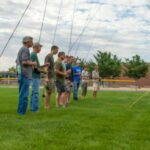 Yes, you read that correctly, electrofishing, and it is pretty much what it sounds like. Sitting in the boat, sending an electric current into the water, then scooping the stunned fish up with nets. Doesn’t sound fair, does it?
Yes, you read that correctly, electrofishing, and it is pretty much what it sounds like. Sitting in the boat, sending an electric current into the water, then scooping the stunned fish up with nets. Doesn’t sound fair, does it?
Matthew Linn, North Fisheries Research Biologist with Indiana DNR, called me to say he would be on Myers Lake doing a fish survey. He asked if I would like to ride along for the electrofishing. I’m sure this isn’t as exciting as a police ride along, but fun for a conservation nerd like myself.
I was unaware, however, that electrofishing doesn’t begin until thirty minutes after sundown, and due to mechanical issues, we didn’t get started until 10:30 pm. My ride, looking straight out of the Beverly Hillbillies, picked me up from my pier, headlamps guiding the way. The boat was loaded with all kinds of gear, the most ominous being the “claws” on the front that are lowered into the water to administer the current. With the safety policies out of the way, life vest and protective gear for my ears, we were on our way.
We slowly set out across the lake, with Matthew doing the driving and following a path that, I’m sure, made sense to him. In the front of the boat, with rubber boots, waders and head lamps were Steven Gratz, Assistant North Fisheries Research Biologist and Andy Opheim, Naturalist Aide. I was tucked in the back in the “splash zone”, which meant that as the guys up front netted the fish, they flung them into a tub right in front of me. I sat very still once I learned that the amount of current in the water could kill me! After about 15 minutes of scooping fish, we stopped to survey our haul.
With only head lamps for light, Steven picked up each fish, identified it, measured it, and if necessary, took a scale sample, which was transferred to Andy for later analysis, calling out the data for Matthew to record, then returning the live fish back to the lake. All this took approximately 20 seconds per fish. The efficient way these guys worked was amazing. I had to ask my questions in the brief 3-4 seconds between fish so as not to interrupt the work flow.
There were no real surprises in what was caught that night however I spoke with Matthew a few days later to discuss the results. Two Northern Pike were caught, which is good news as this type of fish is an indicator of a clear, healthy lake. The pan fish results, Bluegill and Red Ear, were astounding. This confirms what most fishermen in the area already knew, Myers Lake is a great fishing lake, especially for pan fish, but don’t tell anyone else.
The fish survey, along with a vegetative study and other data will be part of a lake study report that will be available sometime next year. Sounds like a best seller and I can’t wait to read it.
More information on Marshall County Soil and Water Conservation District can be found at www.marshallcountyswcd.org or on Facebook.
By Debbie Palmer
MCSWCD














